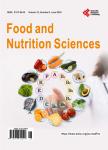Individual Differences in Blood Alcohol Concentrations after Moderate Drinking Are Mainly Regulated by Gastric Emptying Rate Together with Ethanol Distribution Volume
Individual Differences in Blood Alcohol Concentrations after Moderate Drinking Are Mainly Regulated by Gastric Emptying Rate Together with Ethanol Distribution Volume作者机构:Department of Legal Medicine Nippon Medical School Tokyo Japan. Research Laboratories for Fundamental Technology of Food Asahi Group Holdings Ltd. Ibaraki Japan
出 版 物:《Food and Nutrition Sciences》 (食品与营养科学(英文))
年 卷 期:2012年第3卷第6期
页 面:732-737页
学科分类:1002[医学-临床医学] 100214[医学-肿瘤学] 10[医学]
主 题:Individual Differences Blood Ethanol Concentration Moderate Drinking Gastric Emptying Rate Distribution Volume
摘 要:Blood alcohol concentration (BAC) differs greatly among individuals, even when people of the same sex and age drink alcohol under the same drinking conditions. In this study, we investigated the main factors involved in the internal reg-ulation of individual differences in BAC, focusing on the alcohol dehydrogenase 1B (ADH1B) genotype, blood acetal-dehyde concentration (BAcH), amount of habitual alcohol consumption, pharmacokinetic parameters of BAC, distribution volume of ethanol (Vd), and gastric emptying rate (GER) under the same drinking conditions. Twenty healthy Japanese males aged between 40 and 59 years old and having the aldehyde dehydrogenase 2 (ALDH2) genotype of ALDH 2*1/*2 were recruited for this study. The subjects were given 0.32 g ethanol/kg body weight in the form of commercially available beer (5%, v/v). The results showed that BAC-max differed greatly among individuals with a more than two-fold variation. When the BAC-time curve was compared among ADH1B genotypes (ADH1B*1/*1, *1/*2, and *2/*2), there were no differences in BAC among the genotypes. Although BAcH, monthly alcohol consumption, elimination rate of blood ethanol (β value) and ethanol disappearance rate from the body (EDR) can affect BAC, all of them had no correlations with BAC-max. However, Vd (liter/kg), ΔPlasma glucose concentration (ΔPGC = PGC30 min ? PGC0 min) and the serum concentration of gastric inhibitory polypeptide (GIP) did correlate with BAC-max. Model 2 in multiple linear regression analysis showed the optimal model for Vd and GIP with positive correlations with BAC-max. As GIP and ΔPGC are both reflected by gastric emptying rate (GER), we concluded that the individual differences in BAC after moderate drinking are mainly regulated by GER together with Vd. These findings demonstrate that together with body water content, the gastrointestinal tract plays an important role in the regulation of individual differences in BAC, involving first pass metabolism of ethanol.



